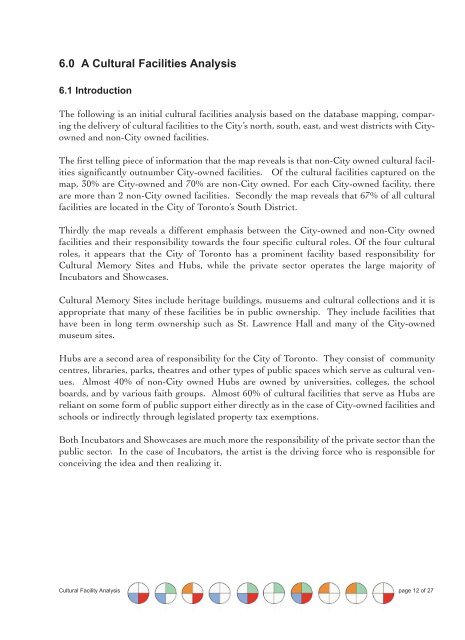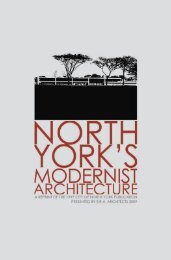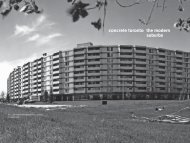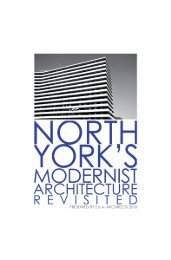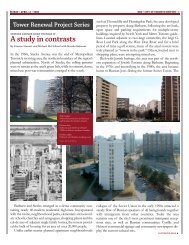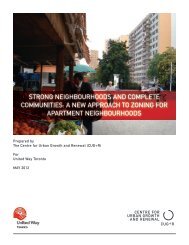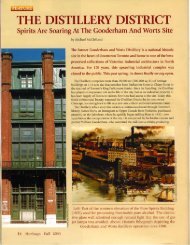A Map of Toronto's Cultural Facilities - ERA Architects Inc.
A Map of Toronto's Cultural Facilities - ERA Architects Inc.
A Map of Toronto's Cultural Facilities - ERA Architects Inc.
You also want an ePaper? Increase the reach of your titles
YUMPU automatically turns print PDFs into web optimized ePapers that Google loves.
6.0 A <strong>Cultural</strong> <strong>Facilities</strong> Analysis<br />
6.1 Introduction<br />
The following is an initial cultural facilities analysis based on the database mapping, comparing<br />
the delivery <strong>of</strong> cultural facilities to the City’s north, south, east, and west districts with Cityowned<br />
and non-City owned facilities.<br />
The first telling piece <strong>of</strong> information that the map reveals is that non-City owned cultural facilities<br />
significantly outnumber City-owned facilities. Of the cultural facilities captured on the<br />
map, 30% are City-owned and 70% are non-City owned. For each City-owned facility, there<br />
are more than 2 non-City owned facilities. Secondly the map reveals that 67% <strong>of</strong> all cultural<br />
facilities are located in the City <strong>of</strong> Toronto’s South District.<br />
Thirdly the map reveals a different emphasis between the City-owned and non-City owned<br />
facilities and their responsibility towards the four specific cultural roles. Of the four cultural<br />
roles, it appears that the City <strong>of</strong> Toronto has a prominent facility based responsibility for<br />
<strong>Cultural</strong> Memory Sites and Hubs, while the private sector operates the large majority <strong>of</strong><br />
<strong>Inc</strong>ubators and Showcases.<br />
<strong>Cultural</strong> Memory Sites include heritage buildings, musuems and cultural collections and it is<br />
appropriate that many <strong>of</strong> these facilities be in public ownership. They include facilities that<br />
have been in long term ownership such as St. Lawrence Hall and many <strong>of</strong> the City-owned<br />
museum sites.<br />
Hubs are a second area <strong>of</strong> responsibility for the City <strong>of</strong> Toronto. They consist <strong>of</strong> community<br />
centres, libraries, parks, theatres and other types <strong>of</strong> public spaces which serve as cultural venues.<br />
Almost 40% <strong>of</strong> non-City owned Hubs are owned by universities, colleges, the school<br />
boards, and by various faith groups. Almost 60% <strong>of</strong> cultural facilities that serve as Hubs are<br />
reliant on some form <strong>of</strong> public support either directly as in the case <strong>of</strong> City-owned facilities and<br />
schools or indirectly through legislated property tax exemptions.<br />
Both <strong>Inc</strong>ubators and Showcases are much more the responsibility <strong>of</strong> the private sector than the<br />
public sector. In the case <strong>of</strong> <strong>Inc</strong>ubators, the artist is the driving force who is responsible for<br />
conceiving the idea and then realizing it.<br />
<strong>Cultural</strong> Facility Analysis page 12 <strong>of</strong> 27


